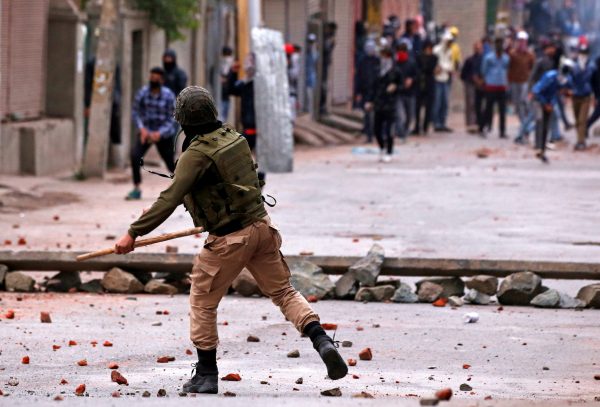Such scenes have become a normal occurrence in Kashmir’s 25-year-long insurgency. Levels of violence spiked in 2016 following the death of Burhan Wani, the local commander of Kashmir’s Hizb-ul-Mujahideen group, and they have remained high since. Each new encounter between Kashmiris and Indian security forces adds to a rapidly growing body of disaffected civilians who are opposed to Indian military presence in Kashmir and are vulnerable to militant radicalisation.
Three parallel narratives inform an understanding of the conflict in Kashmir.
The first is the Pakistan angle. This view emphasises that Pakistan is executing a proxy war against India by sponsoring and financing terrorist groups in the region to wrest Kashmir from India. The second is the freedom or self-determination narrative of Kashmiri Muslims. This narrative includes both Kashmiri Muslims who wish to align with Pakistan and those who want an independent state of their own.
The first two narratives overlap to the extent that the separatist narrative bolsters Pakistan’s strategy to continue its proxy war with India. But the self-determination movement of Kashmiri Muslims who are neither aligned to India nor to Pakistan has been hijacked by extremists in recent years. Kashmiri Muslims’ political aspirations remain largely unaddressed by the Indian state and this makes them vulnerable to militant recruitment and radicalisation.
The third narrative belongs to the minority Kashmiri Pandit (Hindu) community that was driven out of Kashmir during the outbreak of militancy in 1990. Many Kashmiri Pandits were killed during that time, and the community remains displaced and exiled to a life in refugee camps. This group strongly maintains its allegiance to India.
Adding a further layer of complexity to these narratives is the ascendancy of Hindu nationalism in India. Many in power in India subscribe to this ideology and support a majoritarian Hindu state with little or no recognition of minorities. This nationalist sentiment is amplifying the sense of alienation among average Kashmiri Muslims.
The 2014 political alliance between the Jammu and Kashmir Peoples Democratic Party and the Bharatiya Janata Party in the state of Jammu and Kashmir — meant to foster unity between Hindu-majority Jammu and Muslim-majority Kashmir — has only exacerbated the ideological differences between the two parties, each of which must accommodate for very different sets of constituents. The polarisation of the Hindu and Muslim communities in Jammu and Kashmir is not merely political: it is a result of conflicting approaches to dispute settlement, imbued with strong communal undertones.
In the early stages of the Kashmir insurgency, India developed a counterinsurgency strategy that focussed exclusively on the elimination of militants. This strategy shifted to combine the use of military force with a population-centric approach in the late 1990s. This new approach attempts to win the hearts and minds of Kashmiris through the implementation of various developmental and outreach programs. But the multiple narratives at play in Kashmir complicate this counterinsurgency strategy in two critical ways.
First, while the Indian military is succeeding in breaking militant strongholds, its inability to distinguish militants from non-militants is an obvious flaw in its counterinsurgency approach. Protestors and civilians opposed to Indian military presence are branded ‘terrorist sympathisers’ and excessive force is used to make an example of them in some instances.
One such example was Farooq Ahmed Dar, an innocent Kashmiri Muslim who was tied to an Indian Army jeep in 2017 and used as a human shield to push back stone-pelting protestors. Dar was going to the local polls to vote when he was picked up by Army personnel, assaulted and tied to the jeep. Violated by security forces, left jobless and his life destroyed, Dar’s experience paints a grim picture of the poor training and lack of professionalism of the Indian security forces.
The use of antiquated weaponry like pellet guns that have blinded hundreds of protestors over the last few years is another example of the Indian Army’s brutal use of force. These violations are unnecessary and only serve as easy recruitment tools for extremists.
A critical component missing from India’s counterinsurgency strategy in Kashmir is deradicalisation. If India does not begin to address the sources of radicalisation among Kashmiri youth or attempt to separate militants from non-militants, the strategy will remain weak.
Second, while New Delhi will never give up its territorial claim to Kashmir, a mismatch in military and political ends offers a poor counterinsurgency alternative. Successive Indian governments have ignored the political grievances of Kashmiris. Ill-conceived political statements, poor governance by central- and state-government officials, and general apathy only fuel the reactionaries in Kashmir.
Reconciling conflicting Kashmiri narratives without resorting to the frequent or excessive use of force will not be simple, but it would be the start of a smarter Indian policy in Kashmir.
Ayesha Ray is an Associate Professor in the Department of Political Science at King’s College, Pennsylvania. She is the author of The Soldier and the State in India: Nuclear Weapons, Counterinsurgency, and the Transformation of Indian Civil-Military Relations and Culture, Context, and Capability: American and Indian Counterinsurgency Approaches in addition to several international publications on civil–military relations, defence and security. She has a PhD in Political Science from the Department of Government at The University of Texas at Austin.

